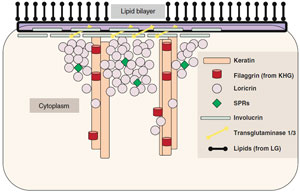Stratum Granulosum| | | | | | Ichthyosis vulgaris: ↓ profilaggrin, ↓ KHG
Lamellar ichthyosis: ↑ profilaggrin, ↑ granular cell layer
Psoriasis: ↑ involucrin, ↓ loricrin, ↑ K6/16 | | | | | |
|
Cells with more flattened appearance; contain dense keratohyalin granules - Granular cells start to lose their nuclei but retain dense keratin filaments
- Expression of K2 (modified from K1) and K11 (modified from K10)
- Keratohyalin granules (KHG): dense stellate globules which contain profilaggrin, loricrin, and involucrin (latter two function in cornified cell envelope)
- Filaggrin: keratin filament aggregating protein in KHG; binds intermediate filaments and organizes into fibrils; initially cleaved from profilaggrin (when granular layer transformed into cornified layer) and is degraded into free amino acids
• Cornified cell envelope (CE) (Figure 1.2): highly cross-linked lipid-rich flexible structure enveloping corneocytes; serves as insoluble exoskeleton and rigid scaffold for internal keratin filaments; provides both mechanical and water permeability barrier | | Figure 1.2 Cornified envelope (CE) |
- CE comprised of lipid layer and several covalently cross-linked proteins: involucrin, loricrin, filaggrin, small prolinerich proteins (SPRs), envoplakin, and serine proteinase inhibitor called skin-derived anti-leukoproteinase (SKALP)
- Loricrin: major protein component of CE, appears in granular layer within KHG along with profilaggrin, cross-links with involucrin
- Involucrin: substrate for transglutaminase cross-linking in granular layer; forms insoluble cell boundary; early differentiation marker; upregulated in psoriasis
|
